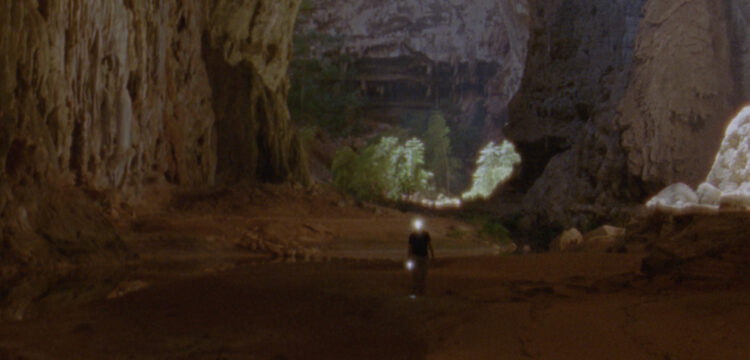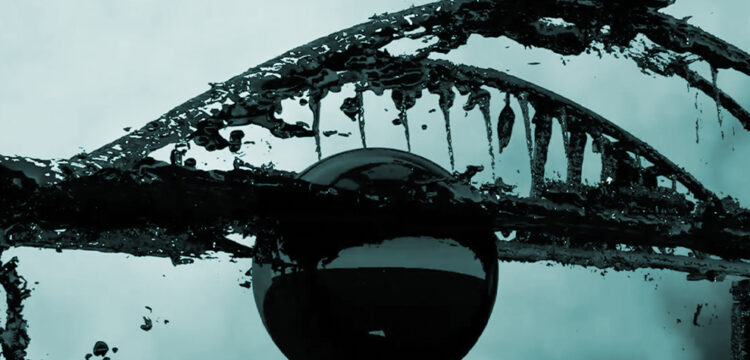The Spring Massacre
A review of Mathilde Rosier’s “Le massacre du Printemps”
Le massacre du printemps, a video-installation by the French artist Mathilde Rosier, which is part of museo Madre collection, is a reinterpretation of Le sacre du printemps, a ballet with music by Igor Stravinsky, created by Vaslav Nijinsky for the Ballets Russes in 1913. The work questions the intrinsic relationship between human beings and the environment, connecting the act of worshipping the earth to that of its subsequent exploitation.
Part of the Madre collection, Le massacre du Printemps is a video-installation by French artist Mathilde Rosier (1973), an exhibition project curated by Andrea Viliani and produced in collaboration with Residency 80121. Inaugurated in October just a few days before the second closure of museums in Italy, the project was meant to be exhibited throughout the spring, when a real “spring massacre” happened globally.
The prophetic boldness toward the spread of the contagious disease did not come as a future prediction but rather as a proper awareness of something that is not yet recognized nor perceived. The instant—the present is more relevant than the future, and this very present is rooted in an obscured past that emerges along many ghosts, materializing both vanished hopes and vanished bodies. A hymn to dance and species that metaphorically disturbs the linearity of history, as an imminent catastrophe reverberates from the video. It is Rosier’s personal re-enactment of Le sacre du Printemps, a ballet with music by Igor Stravinsky, created by Vaslav Nijinsky for the Ballets Russes in 1913. The work stages an environmental apocalypse as mankind’s effect on nature, shifted to a post-anthropocentric and glocal perspective.
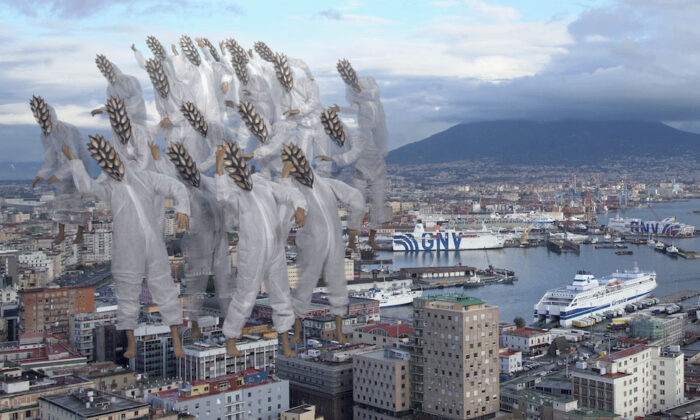
Settled in three different locations across the Campania region—the greenhouses around the Vesuvian area, the port in the city of Naples and the former industrial site in Bagnoli—the work is connected to some historical events that happened in the city. From the anecdotal episode of Picasso’s visit to Naples, to oceanographer Anton Dohrn’s drawings, to the Ballets Russes’ passage in the Amalfi Coast. It is “an agricultural dance on Naples” based on harvest dances and seasonal rituals related to the work in the fields. The ballet is performed by dancers wearing costumes made by the artist, inspired by the work of set and costume designer Nicholas Roerich, and dancing on the music that Rosier composed with a drum and some samples from Jean Sibelius’ symphonies.
The whole pièce followed the original structure of the Stravinsky’s, divided in two parts. The first opens with the act entitled The Adoration of Earth, that recalls the agricultural dances of pagan Russia. Through the adapted choreography, in Rosier’s interpretation the ceremony dedicated to the land becomes a critique of the material conditions of production. Radically transformed by the city’s inexhaustible demand for food and other commodities, the countryside has been reduced to the greenhouses of Pompeii. The dancers’ movements are to symbolize the initiation to land exploitation.
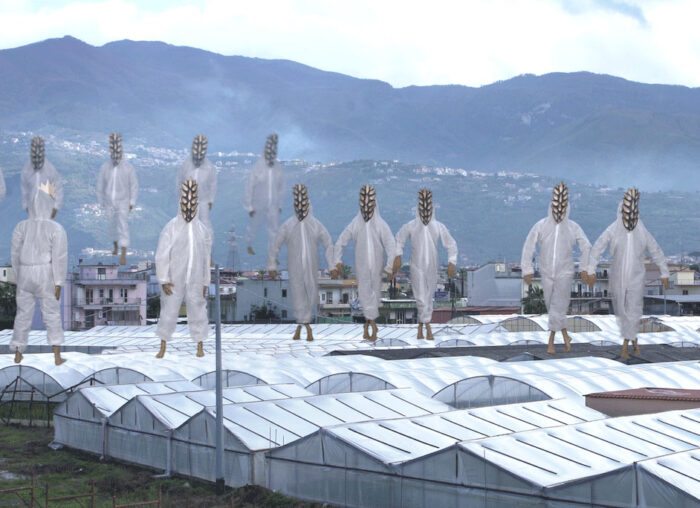
Noise and pollution animate the second set of the video, located in the industrial port and the city center of Naples, completely alienated in their nature. The ritual has now changed into a dramatic dance at the volcano’s feet. Humans became more and more mechanized and less caring, as well as the former industrial site in Pozzuoli’s bay, a place of immense natural beauty now contaminated by human devastation. In fact, in this film the dance takes place in the sky because the ground has become uninhabitable. The camouflage of the dancers’ costumes blended with the colorful façades of the buildings along the Neapolitan coast resonates with the imaginary of the ballets Russes and pays tribute to all the non-human beings victims of the ecological genocide.
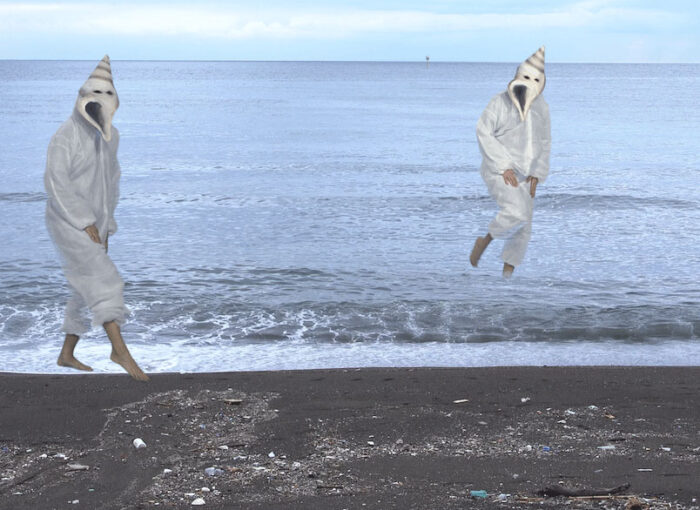
The Adoration of Earth has turned into the Exploitation of the Earth. As the artist declares: “We treat ourselves as we treat plants, industrialized, commodified. The blind pursuit of growth, avidity, greed, only reflect our inability to ever be satisfied. This bottomless dissatisfaction is the reason for the disaster.” In the second act of Stravinsky’s work, entitled The Sacrifice, a woman is designated to perform a sacrifice to the Earth to plead for the return of spring after winter and ensure the perpetuation of the human species’ well-being. In Rosier’s reinterpretation, the sacrifice of the young woman does not take place, instead a mutation happens. The Spring Rite turns into a boundless exploitation, through trans-corporal and trans-species transformations. In the choreography the peasants become ears of wheat, since the destiny of humanity is linked to that of plants, despite the fact that technology has completely consigned this memory to oblivion.
Ghosts of vegetal and oceanic creatures dance on the edges of imagination to urge a different future for this planet. From the blue flow of the sea and of the sky, the choreography is animated with multiform figures that poetically allude to the overcoming of anthropocentrism. The aerial peasants dance, especially emphasizing the jumps, they reinforce both our sense of gravity and our connection to the earth and reciprocal interdependence. Each jump stresses the sense of gravity as it reminds us how the atmosphere we breathe belongs to the earth as well. We do not actually just live on earth, but through it, we are part of nature and we belong to it, along its many entities, in a cosmic fraternity.
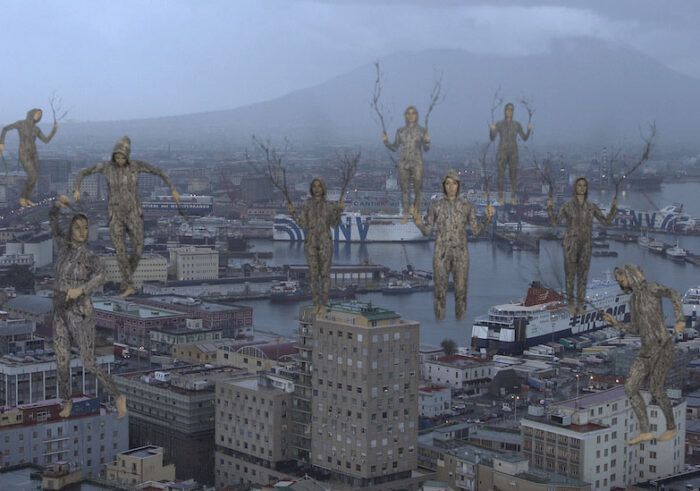
Le massacre du Printemps is both a proposal for a collective ritual and an allegory of the destiny of mankind and its interspecific continuity. The catharsis that is consummated in the Christian iconography of paradise, where the water source is a source of life, becomes a paradigm for the final sacrifice of a particular civilization. In the video, the artist retraces also the Neapolitan religious iconography of the ex-voto paintings, where the Virgin Mary and angels float above the mortals, with the intention to protect the world from chaos. As Rosier says “for many of us, the catholic message failed to answer the ontological question but the image stays with us, the image of an invisible realm of suprahuman creatures capable of filling the feeling of void that makes our chest empty, our heart dry. Maybe those suprahuman creatures are to be found in natural forms, in trees and forest that would inhabit our chest. We have to re-oxygenate our chest with this forest, feel the plenty within us, the lungs and the heart full.”
Ceremonially infused with ancient rituals’ re-enactment, Mathilde Rosier’s works are allowing a certain panpsychism to inhabit again the fissures of a planetary present/past/future, that can no longer be reduced to this human history’s monoculture.




